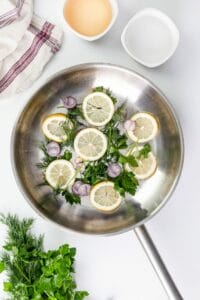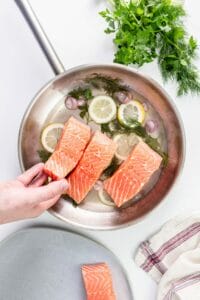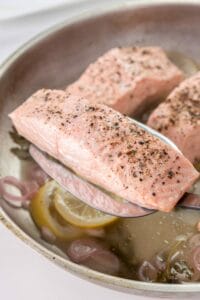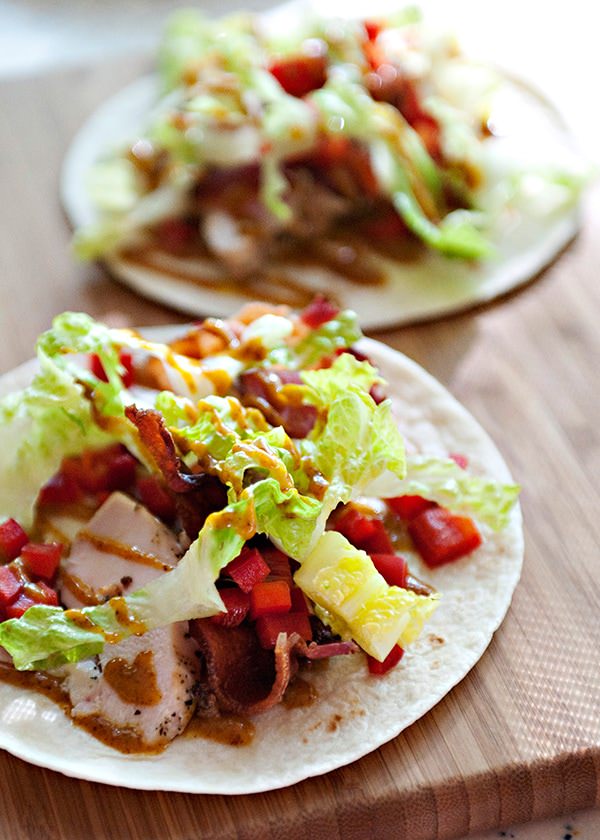Your new go-to method for perfect salmon every time is here! Melt-in-your mouth and foolproof, you’re very welcome.
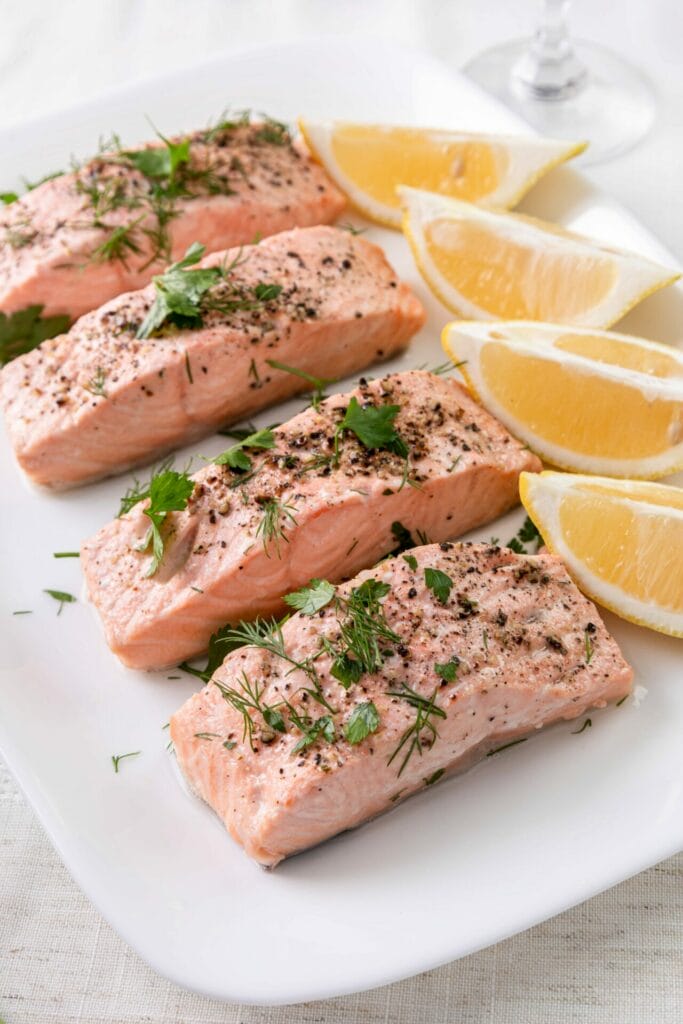
Poaching fish is an age-old practice that involves partially submerging the fish in a poaching liquid until it’s cooked through. The technique is simple, healthy and creates irresistibly tender fish, no matter how lean the piece. There are fancy techniques that involve making parcels out of parchment paper or foil, and the internet is full of those that think poaching it in the dishwasher is the way to go… but we like simple, tasty and easy ways to prepare fish that don’t involve the rinse cycle, and we’re happy to present you with this foolproof method that’ll provide you with tender, juicy, flaky fish every single time.
At its most basic, poaching can be done in plain water. It’s a great way to cook baby’s first chicken, for example, be here at Baked Bree we’re all about the flavor. Wine, herbs, citrus and shallot combine to impart a subtle flavor to the fish without overpowering it, allowing the flavors of the salmon itself to take center stage. As you become more experienced with poaching you can go as wild as you like with the poaching liquid, but here we’re offering a simple, classic formula that we think you’re going to love.
The trick to cooking salmon is to avoid overcooking it, and poaching is a really forgiving way to cook it. Even if it’s a little overdone, it’ll still come out tender and tasty. In a pan or oven, overcooked salmon can be dense, fishy and dry, and it’s why I rarely order it at restaurants. Poaching it, on the other hand, will yield excellent results that’ll get salmon into your regular dinner table rotation.
With warmer weather on the way, we love a simple dinner of this poached salmon paired with this easy rice salad.
Choosing Salmon
In North America, we get to choose between Atlantic and Pacific Salmon. All Atlantic Salmon available at the grocery store is farmed, unless you’re lucky enough to have a local fishmonger who flies it in from Ireland or something. Pacific Salmon is almost all wild-caught. So which should you choose?
In terms of quality, both kinds of salmon are nutritionally similar. All salmon contains significant amounts of Omega-3 fatty acids and dozens of other nutrients. Atlantic salmon is slightly higher in fat, has larger flakes and a somewhat milder flavor. Pacific salmon is deeper in colour, has a more robust taste and a finer texture.
The choice is yours. If eating wild-caught fish is a priority for you, then Pacific salmon is the way to go. If milder flavors are your priority and you prefer your fish more well-done, then Atlantic salmon is the better choice.
Whichever salmon you choose, you’re in for a treat. Try to get pieces of similar size and thickness to make sure they all cooked to the same level of doneness.
Ingredients
- 2 lemons one thinly sliced for poaching, the other cut into wedges for serving
- 1 small shallot thinly sliced
- A handful of fresh herbs such as dill, parsley, or tarragon
- 1/2 cup dry white wine
- 1/2 cup water
- 4 salmon fillets 6 ounces each
- Kosher salt to taste
- Freshly ground black pepper to taste

How to Make Poached Salmon
Step 1: Start by creating a flavorful bath for your salmon. In a large skillet, combine the thinly sliced lemon, shallot, and fresh herbs. Pour in the white wine and water and let it all simmer gently over medium heat.

Step 2: Once your poaching liquid is simmering, it’s time to introduce the salmon. Lay the fillets skin-side down in the skillet. Sprinkle them with a pinch of kosher salt and a twist of black pepper. Cover the skillet with a lid to trap the steam and let the salmon poach for about 5 to 7 minutes. The exact time will depend on the thickness of your fillets, so keep an eye on them. You’re aiming for salmon that’s just cooked through and still moist.
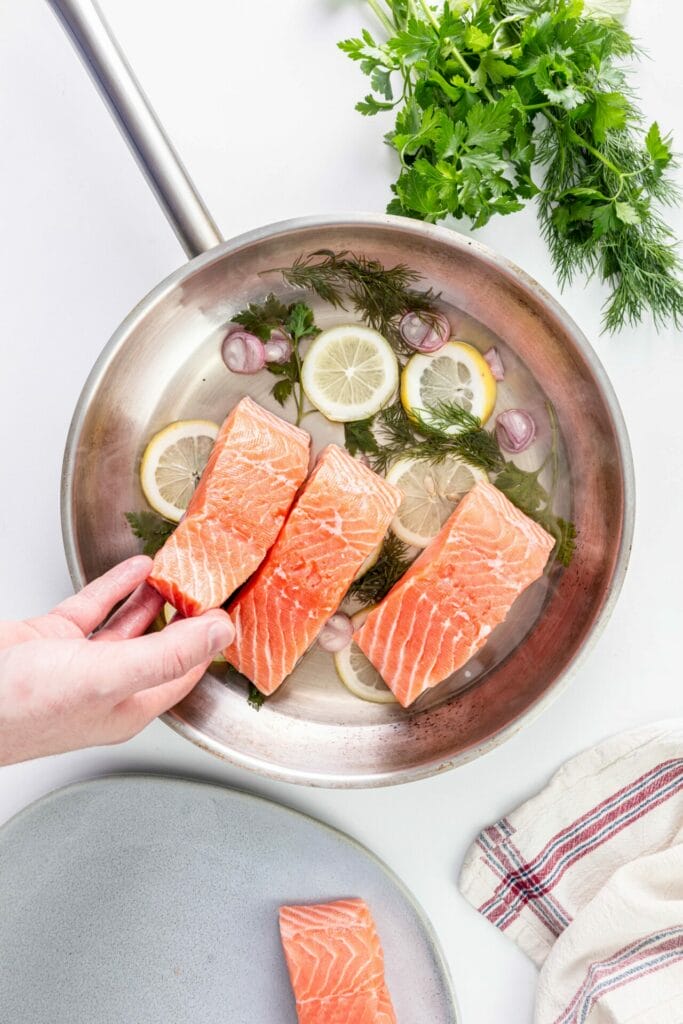
Step 3: When the salmon is ready, it’s all about presentation. Carefully transfer the fillets to plates and top each one with a sprinkle of fresh herbs. Serve with a lemon wedge on the side.

FAQs & Tips
The poaching liquid can be prepared in advance and stored in the fridge until you’re ready to cook. Once simmering the whole process will only take about 5-7 minutes, so leave the fish as the last thing to do after you’ve prepared the rest of the meal.
Leftover salmon can be stored in the fridge for up to three days. We love to eat it cold on a salad for lunch, or with with a bagel and cream cheese. You can also flake up leftovers into a sandwich filling with mayonnaise and green onions.
Gently insert a fork between flakes of the flesh at the thicker end of the fillet. The flakes should part easily and the flesh should be slightly shiny and translucent in the middle. If you like it more well done, poach it an extra couple of minutes until all the meat is opaque.
You certainly can. Dill and parsley are quite traditional herbs used, but some tarragon and thyme will give you a French vibe, go more Italian with some fennel and basil, or get all Spanish with saffron and tomatoes. One of the great things about poaching is that changing the liquid can completely change the dish, even though the technique stays the same.
Not at all. Heating the wine boils off the alcohol, and once the volume is reduced by about 15% there is very little alcohol left in the pan. If you want to avoid using wine altogether, try substituting vegetable stock, some miso paste or a few drops of soy sauce.
Sure! Strain the poaching liquid through a sieve and pour it back in the pan on medium-low heat. Mix a teaspoon or corn starch with a few tablespoons of water and stir it up to make a slurry. Pour this into pan and heat it though until it’s thickened into a sauce, about 30 seconds. If it’s too thick, just add a little broth or water to get it to the consistency you want.
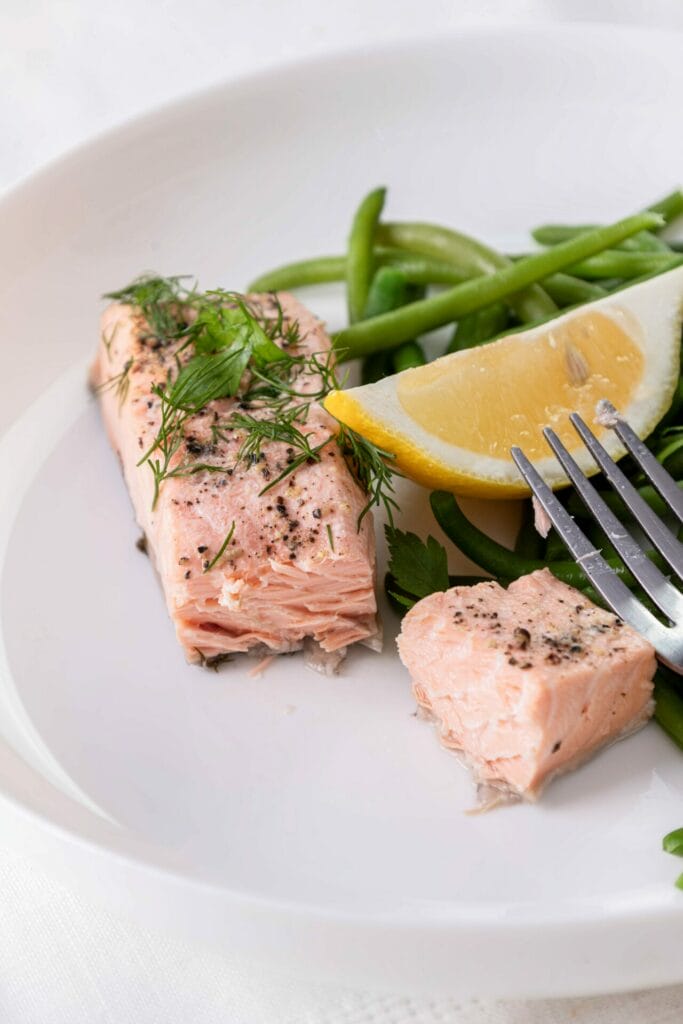
Serving Suggestions
We love this salmon with https://bakedbree.com/mediterranean-rice-salad for a light meal, especially on a warm day, or served with a pilaf. It also works beautifully with really simple sides: boiled tiny potatoes tossed in herb butter and steamed asparagus make for a truly elegant meal.

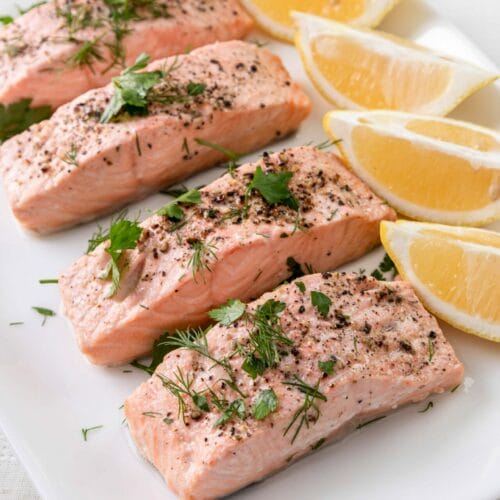
Poached Salmon
Ingredients
- 2 lemons one thinly sliced for poaching, the other cut into wedges for serving
- 1 small shallot thinly sliced
- A handful of fresh herbs such as dill, parsley, or tarragon
- 1/2 cup dry white wine Chardonnay or Sauvignon Blanc work well
- 1/2 cup water
- 4 salmon fillets 6 ounces each
- Kosher salt to taste
- Freshly ground black pepper to taste
Instructions
- Start by creating a flavorful bath for your salmon. In a large skillet, combine the thinly sliced lemon, shallot, and fresh herbs. Pour in the white wine and water and let it all simmer gently over medium heat.

- Once your poaching liquid is simmering, it’s time to introduce the salmon. Lay the fillets skin-side down in the skillet. Sprinkle them with a pinch of kosher salt and a twist of black pepper. Cover the skillet with a lid to trap the steam and let the salmon poach for about 5 to 7 minutes. The exact time will depend on the thickness of your fillets, so keep an eye on them. You’re aiming for salmon that’s just cooked through and still moist.

- When the salmon is ready, it’s all about presentation. Carefully transfer the fillets to plates and top each one with a sprinkle of fresh herbs. Serve with a lemon wedge on the side.

Nutrition


